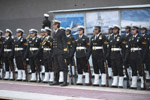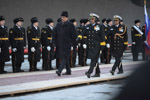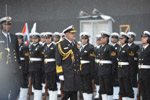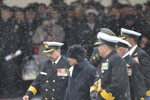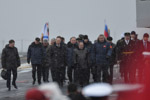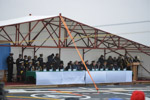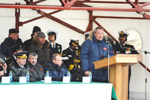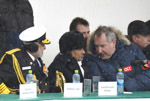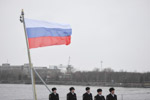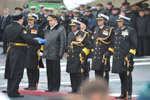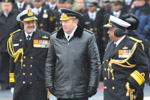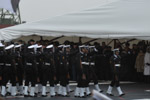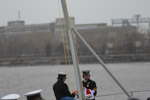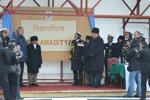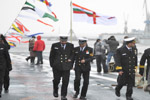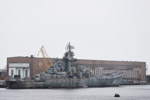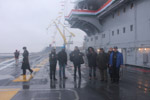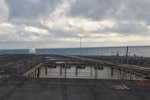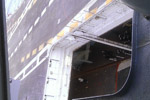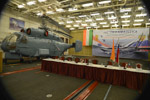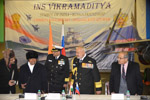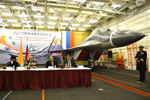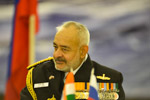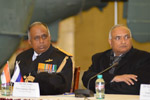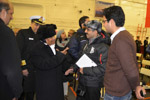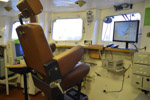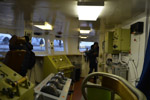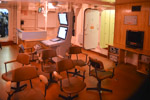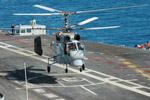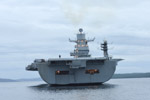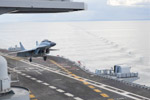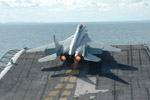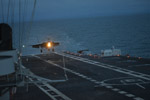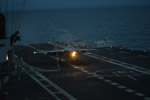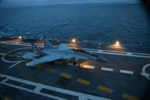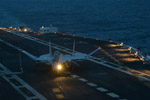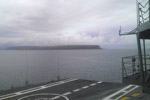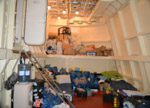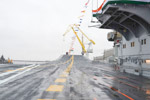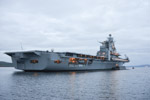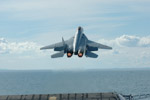Meantime, the newly inducted aircraft carrier, 45,000-tonne INS Vikramaditya, is at sea. To our knowledge, she is still in the Russian waters, taking shelter in one of the Russian Navy’s Northern Fleet testing ranges in the expanse of the Barents Sea. There, she waits for some unexpected storms to the west, on her way home, to calm down a bit. It is also known that, soon after departing Severodvinsk in the morning of 26 November, INS Vikramaditya made rendezvous with the INS Deepak fleet oiler. The latter had arrived at Murmansk for the purpose of accompanying the carrier all the way to Karwar naval station, where she will be based. Arrival in home waters is scheduled for January 2014.
The handover ceremony for INS Vikramaditya took place in Severodvinsk on 13 November. The central part was signing the act of acceptance. This was done by the Commanding Officer (CO) Suraj Berry and Igor Sevastianov, deputy general manager with Rosoboronexport (the Russian governmental arms-trade agency held the contract for Gorshkov refit and modernization). Soon thereafter, Berry read out loud the Indian government order to put INS Vikramaditya into service and assign the ship to the Western naval command. With that, the Russian tri-color flag was winded down and Indian naval ensign hoisted up.
The story of India acquiring an aircraft carrier in Russia is a long and eventful one. Soviet navy Admiral Gorshkov heavy aircraft-carrying cruiser of Project 1143.4 was laid down back in 1978 and went into commission nine years later. After a short service, it was made redundant due to high operational costs and withdrawal of Yakovlev-38 vertical takeoff and landing jets. The cruiser was offered to India in 1995. Terms of purchase were agreed in April 2000. That time the costs were estimated at 400 million US dollars. The initial contract worth 617 million was signed in March 2004. It called for the cruiser to undergo refit and modernization into the Project 11430 through-deck carrier. But costs escalated, and in 2010 the sides renegotiated the contract for 2 billion. With training/logistic packages and shore facilities counted in, the grand total rises to 2.33 billion.
Whilst suffering from the freezing weather up north, the Indian seamen looked happy, for their “dream carrier” had been added to the national assets. Selected seamen in parade uniforms lined up on the Sevmash Main Jetty along the ship’s starboard side as early as 8:45am. Dignities and military leaders began to arrive about 10am. Admirals were first to appear. Chief of the Naval Staff admiral Devender Kumar Joshi listen to his inferiors’ reports and make a slow pass along the whole line of the Indian and Russian servicemen.
Later that day, admiral Joshi made a speech. “Very early in its existence as a nation state India realized the necessity to operate aircraft carriers. Given the vast expense of our maritime seascape and far-flung allied territories, national interests and national security responsibilities, regional commitments and extremely dynamic geostrategic environment, the need for maritime capability set on modern aircraft carriers is fundamental. INS Vikramaditya bridges the time gap between the existing capability and our indigenous aircraft carrier project due for commissioning in the near future. Integral with the MiG-29 fighters, Kamov-31 AEW and other multirole helicopters, INS Vikramaditya is a significant step in the direction of achieving our medium term aim of two operational aircraft carriers available at any given time. From the time the project was conceived to its fruitification today, it had its own challenges which have been successfully overcome. Transforming the heavy cruiser into a magnificent and lean aircraft carrier was certainly no simple task. Activation of preserved machinery and equipment, and incorporation of numerous high end new technologies, setting up of multifunctional aviation facilities complex and integration of MiG-29K fighters and Kamov-31 helicopters became possible to the skills, sweat and pain of the workers at Sevmash Shipyard, Nevskoye design bureau, all participating OEMs and the navies of our nations. I take this opportunity to express my gratitude to the Russian navy for direct participation in the sea trials and sharing of their vital experience with us. Without your support, successful termination of the project could not have been made possible. Through this project the Indo-Russian strategic partnership reached new heights and I am sure that we will continue to cooperate to raise our strategic partnership even further”.
Later, Joshi addressed the media in the carrier’s huge hangar: 130-meter long, 22.5-meter wide and 6.6-meter high. He said: “Commencement of [MiG-29K] flight operations has already been made. Flights are already in progress, including by the Indian air crews. Full operations of the [INAS303 “Black Panthers”] squadron will be done when the ship is in India. The aircraft are already with us, the air crews are already trained on type. The only residual aspect is deck [takeoff and landing] qualification and that will happen very soon. As far as the shipyard is concerned, whilst Sevmash had had its narrow specialization in the very niche area, and small experience as far as surface warships are concerned, we had no doubt at all that skills and workforce of Sevmash would be able to undertake this task. The product is now for all of you to see: it has been done with total competence and professionalism. We are very happy about the ship”.
Since 1965, Russia has been the major supplier of warships to the Indian navy. The earliest contracts called for supply of four Project 641I diesel-electric submarines, five Project 159E corvettes and five Project 368P motor boats. Since then, over seventy Russian-built warships have been commissioned by the Indian navy. Most modern of them are six Talwar class frigates (Project 11356) armed with the Indo-Russian BrahMos Mach 3 cruise missiles. The first of them has been in service for ten years now. Russia offers the customer to place order for additional, third, batch of such ships, comprising three more hulls, and promises to deliver those “in a very short time”. Other proposals prepared for the Indian customers are license production of Kamov rotorcraft with a high degree of localization and a second nuclear powered submersible vessel to add to the Chakra II, a Project 971I fast-attack submarines on ten-year lease from January 2012.
Honorable Raksha Mantri Arakkaparambil Kurian Antony gave attendance to ceremony in Severodvinsk. Addressing the audience, he said. “Today is a big day for the whole Indian nation, and also a historic one for the Indian navy. A landmark day, a milestone for India-Russia military cooperation. Indian policy is to be friendly with all countries… but India-Russia relations are very-very special… and time tested. Through the long years of friendship, Russia helped us to strengthen our national security in many areas. Today’s commissioning of Vikramaditya to the Indian navy is a shining example of the strong relations between the two countries. I am sure in the years to come these relations will be further strengthened”.
Possessing a modern and potent tool to project power in any chosen maritime direction fits well into the national defense policy. India has a rich maritime history and, according to A.K. Antony, “the Indian Ocean has guided our fate over the centuries”. “India’s economic development is dependent on the seas, and safeguarding the nation’s maritime interests is central to our national policy. Aircraft carriers have been part of the Indian Navy’s force structure since our independence and have effectively served the country over the past five decades or so. The induction of Vikramaditya with its integral MiG-29K fighters and Kamov-31 helicopters, not only reinforces this central policy, but also adds a new dimension to our Navy’s operational capabilities”.
Later, making his remarks to the journalists, the defense minister said: “After nine years of waiting, at long last, the Indian navy has got Vikramaditya. Now I can tell you, I can confirm, that there was a time when we thought this project might never materialize due to the many difficulties and challenges. But everyone worked so hard, tirelessly, and, ultimately, we have overcome all challengers and Vikramaditya has become a reality. I am very happy and proud to be present here after the ship’s commissioning. I am sure that this addition of Vikramaditya will further strengthen operational capabilities of the Indian navy, and that this addition of Vikramaditya will help the navy in matching the ever-increasing challenges in the area of maritime security and coastal security”.
The defense minister responded to the claim that the story of acquiring a carrier in Russia may provide a shining example of huge cost overruns and extensive delays. He said that the initial “decision for Gorshkov or Vikramaditya” was made by “the government of the day, when was another defense minister”. These decision makers “might have given the work to Sevmash in a great hope and confidence”. Severe delays with delivery of promises followed. Closer ship inspections in the dry dock rendered the previously agreed contract sum woefully inadequate to complete the work. “Then we realized that the main cause for the delay was so many serious challenges in materialization of this project”, the minister said. “It was the most difficult project the Indian military ever pursued over the long years of the military technical cooperation between the two countries. But it was only one of the many projects. Russia has long been helping us in the area of defense … our relations are time-tested relations… and, in the end, we have overcome all the challenges. I am sure our relations will be further strengthened in future”.
Russia’s main speaker at the handover ceremony was deputy prime minister responsible for the military industrial complex Dmitry Olegovich Rogozin. Calling India “as the privileged, strategic partner and a close friend”, he said that Russia is interested in seeing her allies to live in peace and prosper. By handing over the powerful carrier to the Indian navy, Russia makes a significant contribution to strengthening the Indian defense capability. With that, the peace in the region will be reassured, the Russian deputy PM added. “Such a modern and potent combat ship shall, by her awesome appearances, powerful weaponry and well-trained and qualified crew, make the enemies of India shiver”. He rendered his cordial congratulations to A.K. Antony with “the acquisition of such a serious and potent asset”.
INS Vikramaditya is designed to provide basing of the MiG-29K/KUB multirole fighters and Kamov Ka-31 radar picket helicopters. The ship can also operate the Chetak search and rescue helicopter. Provision is also made for “on demand” flights of the Sea Harrier short takeoff/vertical landing aircraft, Sea King antisubmarine warfare helicopter and the indigenous Advanced Light Helicopter (ALH). The LCA-Navy was not specified in the contract for this carrier.
Vikramaditya’s main weapon is the MiG-29K/KUB. The carrier can take onboard up to 24 multirole fighters. The airplane’s combat range of 1,500km can be extended through use of “body stores” or mid-air in-flight refueling sets. These enable one aircraft acting as a tanker to transfer fuel to another MiG. Guided by the Lesorub-E combat information management system, such aircraft are potent interceptors. The Zhuk-ME airborne multimode radar fitted to the MiG can track ten aerial targets simultaneously and guide four RVV-AE beyond-visual range air-to-air missiles onto separate targets at a time. The MiG-29K can carry RVV-AE and R-73E air-to-air, Kh-31P anti-radiation, Kh-31A and Kh-35E air-to-surface missiles with active radar heads, as well as KAB-500KR/KAB-500OD guided bombs with TV heads. The aforementioned Zhuk-ME radar can allocate and track a destroyer at a distance of 300km. The Indian navy air arm operates twenty such aircraft out of 45 on order.
The planned arrival of INS Vikramaditia in the Indian Ocean in January 2014 shall make possible her visual comparison with the navy’s current flagship, INS Viraat. INS Vikramaditya’s full displacement is 45,000 tons, compared to Viraat’s 28,700 tons, with a length of 283.5 meters compared to 226.5 meters, and a width of 59.6 meters versus 48.8 meters. A big ship with a formidable air wing, INS Vikramaditya shall be able to exercise sea-control over a three-dimensional bubble of 400-450 mile radius. With the INS Vikramaditya having gone into commission, the Indian navy has acquired the long hand it never had before. This is reflected in the ship’s moto “Strike far, Strike sure”.
Photoreport:
Commissioning of INS Vikramaditya. Severodvinsk, 16 November 2013 (some shots the author took during sea trials in August).







